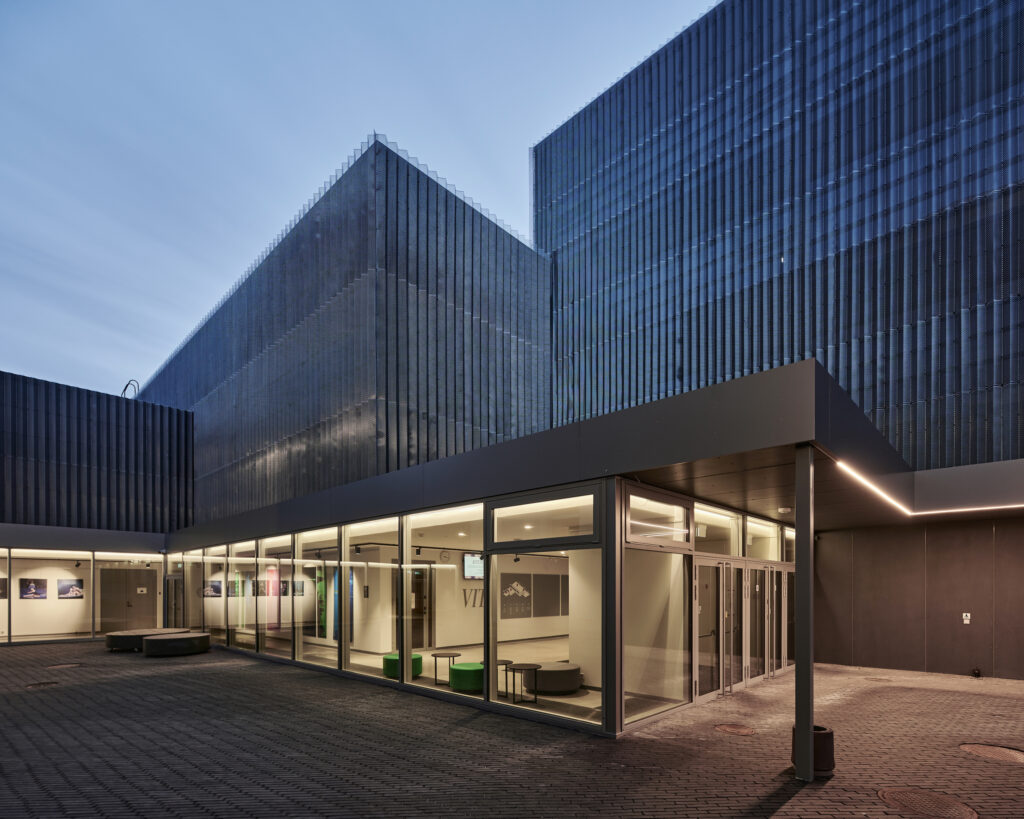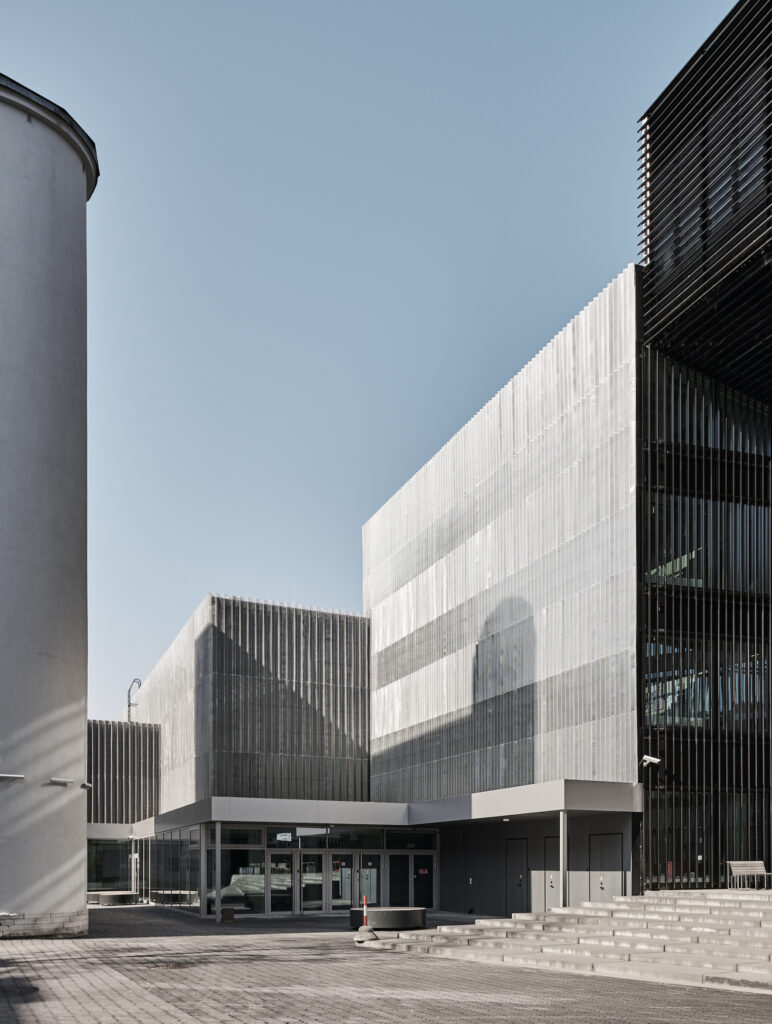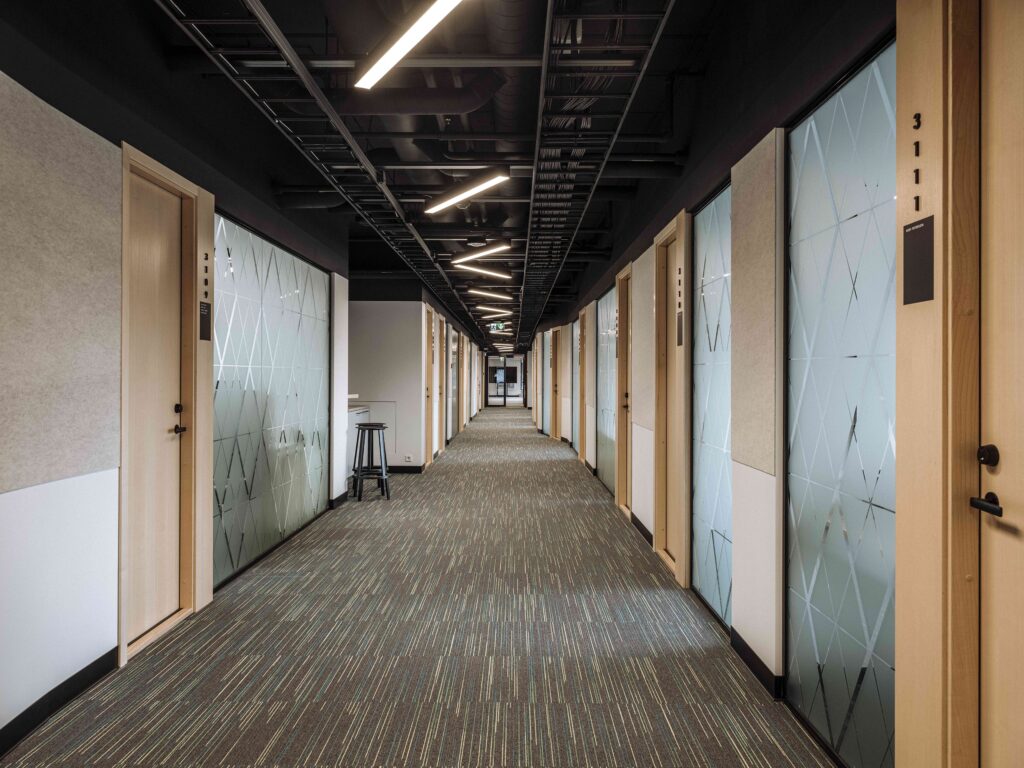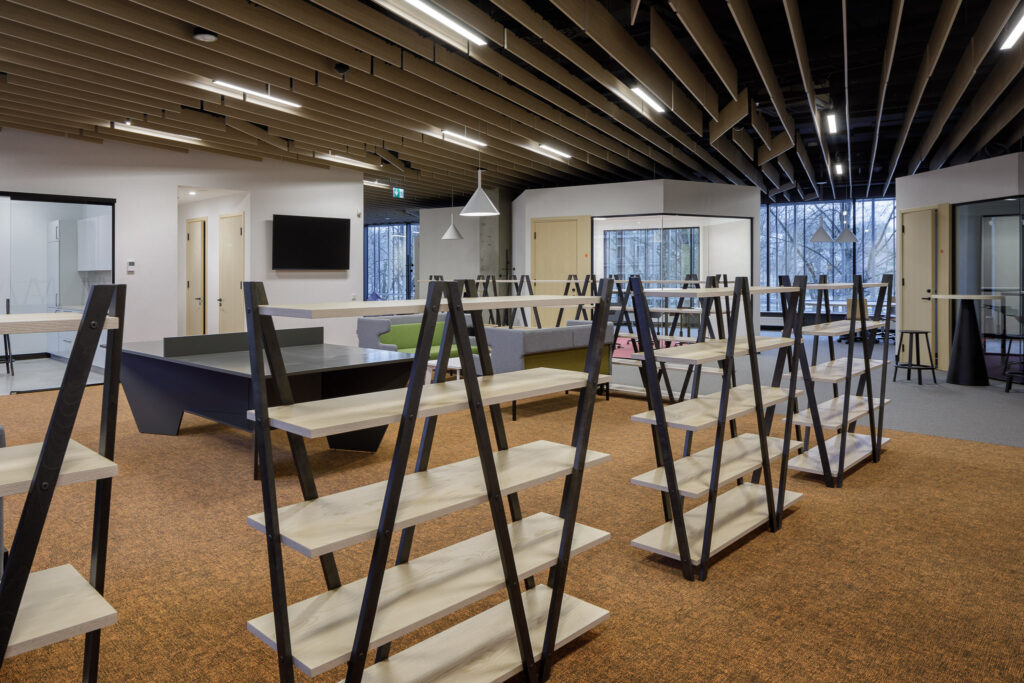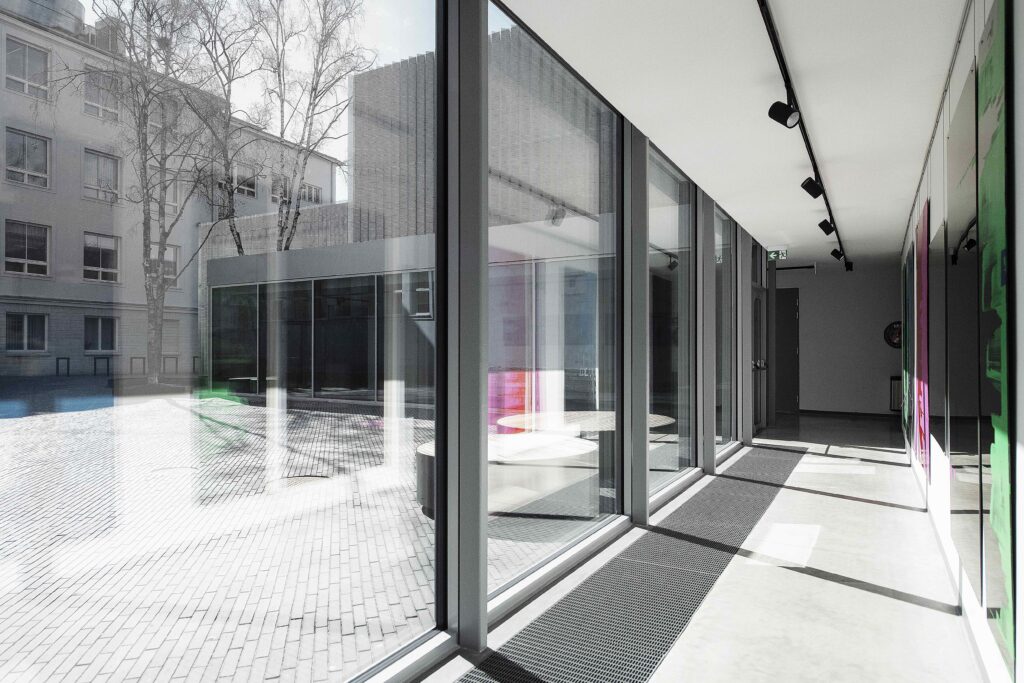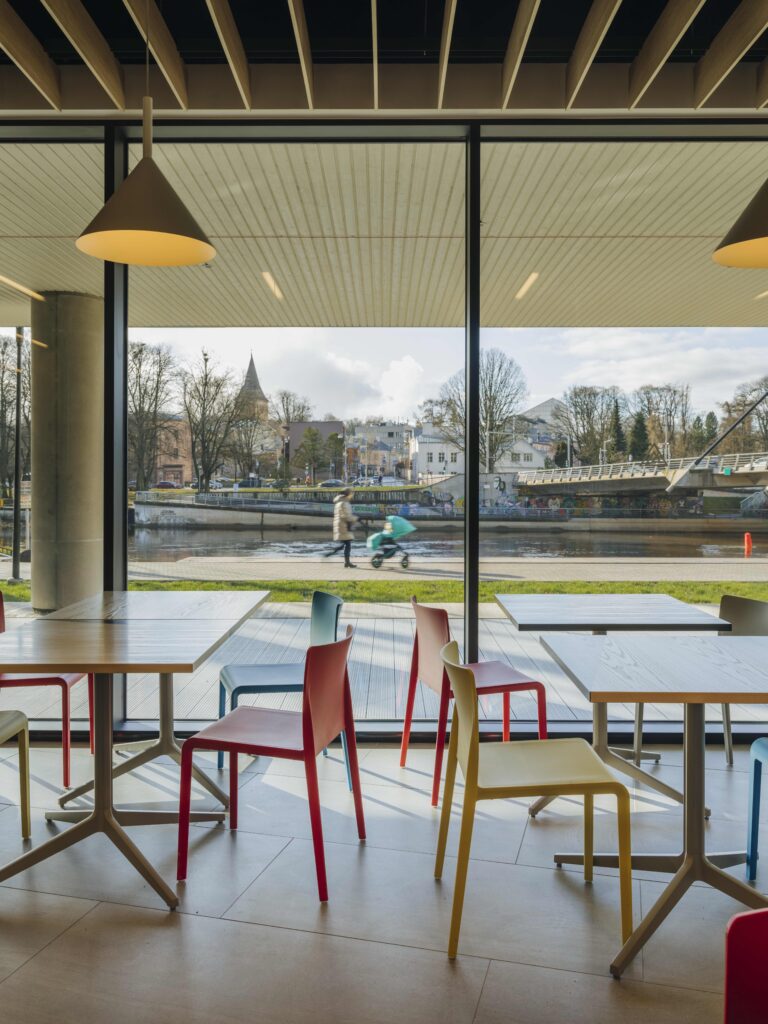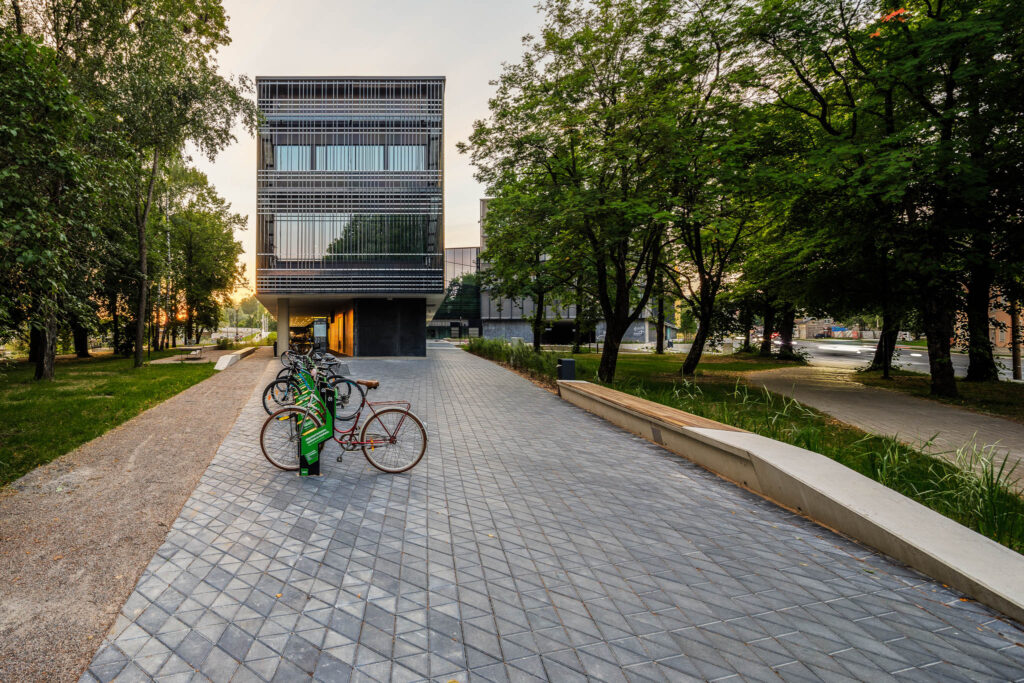How can human well-being and cognitive processes benefit from evidence-based design? We discuss it on the example of teaching and research facility in the Delta Centre of Tartu University and the creative house Vita of Tallinn University.
Introduction
In 1923, a research project was initiated in Western Electric’s factory in the Hawthorne suburb of Chicago to prove scientifically that better artificial lighting in factories would increase worker productivity1. These ‘illumination studies’ mark the beginning of the scientific study of work environments, well-being and productivity. When illumination was improved in the factory, productivity increased, leaving the impression that better illumination had a progressive effect. When the conditions worsened, productivity still continued to rise. At the end of the experiments, it was concluded that artificial lighting had no effect on productivity. But the results were puzzling.
Researchers reasoned that the rise in productivity came from workers’ awareness of being observed. They just worked harder in fear of being fired. The phenomenon that behaviour during an experiment can be altered by the subject’s awareness of participating in the experiment is called the Hawthorne effect. Over the years, however, the Hawthorne experiments have attracted strong criticism2. Re-analysing the data showed that more artificial lighting actually did improve performance3. However, the Hawthorne effect itself is not backed by empirical evidence. The supposed effect can be explained through different social mechanisms4. So what can we learn from all this?
Human-environment interaction models are useful tools in the hands of experts. These models help to prevent design-related mistakes. Avoiding false negatives like ‘light has no effect on productivity’ and false positives like ‘productivity rises due to the Hawthorne effect’ is essential. This interaction, however, is not always straightforward. An environmental stimulus does not evoke only one certain reflex-like behaviour. Same stimulus might have different outcomes and different stimuli might evoke similar behaviour. There are psychological and physiological mechanisms behind behaviour that go against common knowledge and logic. Knowing what these mechanisms are can give us a better understanding of how the environment impacts us.

The workplace
Ralf Speth, Chief Executive Officer of Jaguar Land Rover has said, ‘if you think good design is expensive, you should look at the cost of bad design’. Architectural qualities can affect through cognitive mechanisms key behaviours that are essential for success when trying to achieve organisational objectives5. In the beginning of the millennium, the cost of an average office building made up 5% and operating costs 3% out of the total costs of working for 10 years. Salaries took up 82% and are still the highest expense. It seems reasonable to invest in physical settings in the long run. Small investments in the physical environment can pay off well, if they enable individuals to be more effective.
Studying the effects of work environments to worker satisfaction and well-being has been gaining more attention6. Organisations struggle with finding ways to contain growing facility expenses while meeting the functional needs of diverse kinds of work and preferences. This leads employers to search for ways to design workplaces that not only meet the environmental needs for satisfaction, health, and well-being, but also promote effectiveness. Even though the essence of work has changed over time7, the fundamental characteristics of people have not8. Understanding how environments affect comfort, satisfaction, performance and health comes through the study of privacy, attention, stress, affect and cognition8. In the case of offices, this comes down to designing with the employees’ needs in mind, providing solutions for both collaborative and individual-focused work7.
Similarly to work environments, some features of the study environment may help students to pay attention whereas others may be a source of distraction. Psychological processes necessary for learning like attention and distraction, cognitive fatigue and restoration, emotions and motivation have specific relationships to the physical environment9. Sustaining attention over a long period of time may result in cognitive fatigue, a decrease in learning, and need for cognitive restoration. Features of the environment can help with restoration and affect motivation for attending lectures and learning.
Private and public space are intertwined in the universities where knowledge work and studying takes place. It is hard to take everyone’s individual preferences into account, but one can consider general working principles of the mind when designing for people. Privacy, control, auditory and visual stimuli, physiology, stress, attention, cognition and mental restoration are discussed at the example of the teaching and research facility in the Delta Centre of the University of Tartu and the creative house Vita of Tallinn University.
DELTA CENTRE, UNIVERSITY OF TARTU
Architecture: Illimar Truverk, Sander Aas, Timo Titma, Sander Paljak, Eero Endjärv, Janar Toomesso / Arhitekt11
Interior: Kaur Käärma, Sander Aas, Illimar Truverk / Arhitekt11
Landscape: Kristian Nigul ja Kadi Nigul / Väli
Engineering: Arro & Agasild Inseneribüroo
Technical systems: AS Hiieko ja ITK Inseneribüroo
Graphics: Velvet
Constructed by: Ehitustrust, Rand & Tuulberg Grupp
Client: University of Tartu
Plot area: 13 762m2
Building net surface area: 27 700m2
Project: 2016-2018
Construction: 2020
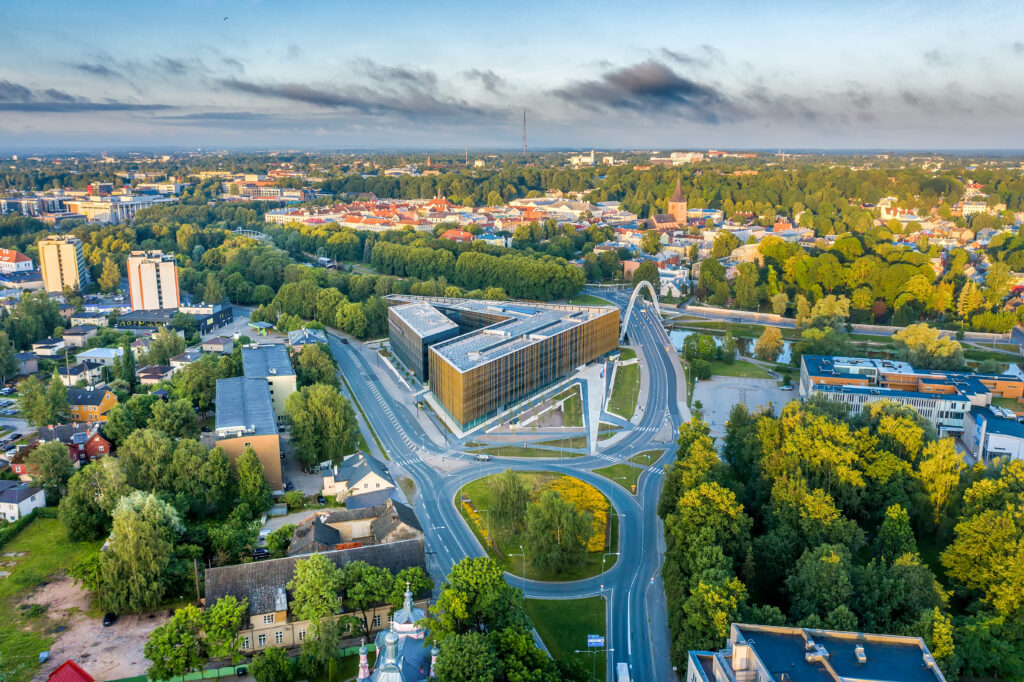
The Delta Centre consists of the teaching and research facility and the business building. There is Institute of Computer Science, Institute of Mathematics and Statistics, School of Economics and Business Administration, Institute of Technology, and Centre for Entrepreneurship and Innovation as a support unit. There are different-sized classrooms, laboratories, work and leisure areas for students, library, offices and leisure areas for faculty. The building is meant for approximately 400 workers and more than 2500 students. Collective spaces for students, scientists and lecturers are meant to support collaboration. There are different financial, scientific and innovation companies renting in the other building.
CREATIVE HOUSE VITA OF TALLINN UNIVERSITY
Architecture: Maarja Kask, Ralf Lõoke, Pelle-Sten Viiburg, Martin McLean / Salto
Interior architecture: Tarmo Piirmets, Raul Tiitus / Pink
Planting: Maarja Gustavson / Polka
Constructed by: Ehitustrust
Client: Tallinn University
Building net surface area: 3986m2
Commission: 2016
Completed: 2020
The creative house Vita is the replacement of the old Ursa building. There are two institutes and different student organisations operating there: Baltic Film, Media, Arts and Communication School (BFM), School of Natural Sciences and Health (SNSH) and various sports collectives. There are dance halls, blac kbox, music classrooms, audio studio, art studios, IKUMUMU studio, gymnasium with a tribune for spectators and a gym.
Spatial organisation
Given the desire to increase collaboration and communication, the open-plan space has been trending over the past decades10. The belief that reducing barriers promotes communication, collaboration and creativity is widespread8. However, the problems experienced with the open-plan approach have been widely documented11. Different studies indicate that enclosed private offices outperform open-plan offices in employee health, sick leave rates, job satisfaction and performance, and social relations.10,11 In a 2018 study of an open-plan office in an architectural company architects and designers were those who suffered the most.10 Privacy and communication are two important considerations in knowledge work environments. More opportunities for communication often tend to reduce privacy.8 There is convincing evidence that the benefits of allowing for more privacy usually outweigh the disadvantages from decreased communication.12 Privacy—conversational, visual and auditory—has been known from the massive BOSTI Associates studies to be one of the most important design aspects for employees since the 80s.13
Why is privacy important?
Our organism adapts to changes in the environment each time a new stimulus reaches our senses. In order to concentrate on something, other stimuli in the brain must be inhibited at the same time.14 This takes a toll on the workings of our brain. This is relevant when directed attention is used, like when working or studying. In the case of overstimulation, our brains take measures to suppress stimuli not related to the task at hand.15 However, the neurons related to inhibition get tired rapidly.16 When this happens, our ability to pay attention and not let ourselves be distracted suffers. In sum, we need peace and quiet to effectively work and study.
The need for privacy when working, studying and in common space
What do we need to consider when addressing the issues of privacy? Open-plan offices are a source of stress when the need for privacy is not fulfilled by the design. Most open-plan offices that were proposed in the beginning, were given up in favor of individual work in both buildings. Do these new environments work like they were initially intended? Open-plan office on the fourth floor of the creative house Vita was decided at the request of the study specialists to be redesigned into small cubicles. But in order to have privacy employees are isolated from natural light, restorative views and proper ventilation.
Glass partition walls in Delta Centre’s teaching and research facility provide more light and openness through the cabinets to the centre of the building. Semi-transparent opaque stickers were installed to ensure privacy. However, in some of the office rooms, employees have covered the glass partitions for more retreat with bookshelves. These are a few examples of how important privacy really is for employees, and of the measures they take to achieve it or how the environment is used differently than the initial proposal. However, such tradeoffs should not happen at the expense of a healthy work environment.
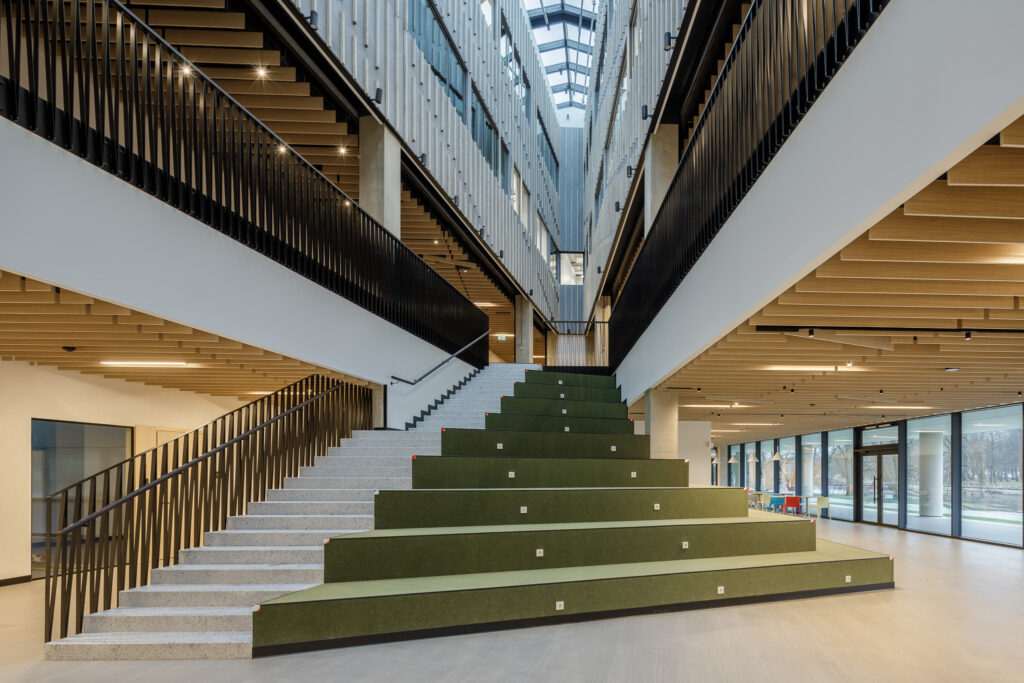
The same applies for learning environments. Possibilities not to be disturbed are paramount. The Delta Centre’s teaching and research facility has a multifunctional study and leisure area. There is an open shared space with curtain partitions for for dividing the room and for more privacy. There are additional cubicles with sound cancelling panels for individual work or calls, and smaller rooms for group work with glass partitions. Students can choose between solutions with different degrees of privacy. Open to the hallway, passersby might compromise the ability to focus in the room with glass walls.
The creative house Vita has dedicated floors and studios for students according to the curriculum. Studios are equipped with opaque curtains to divide the room for privacy. Two exits are on the sides of the room, making occasional passersby less noticeable. Dedicated classrooms function as permanent open-plan shared space offices for students. Rooms allocated according to the curriculum gives more privacy in one’s environment, since extraneous students do not have access to the studio. The computer classroom is visually open to the corridor. Half of the workstations face the hallway. Our brains get information about our surroundings from peripheral vision all the time. This enables us to maintain situational awareness.17 Attention is an inherently limited resource, because the increase in firing rate at the neuronal level is metabolically expensive. Any stimuli unrelated to the task at hand might disrupt concentration. Sharing your screen with whomever is passing by also lowers the amount of privacy and causes stress because of the uncertainty.
Lecture halls in the Delta Centre’s teaching and research facility have glass partitions covered with stickers to conceal people walking in the hallway. Although opaque stickers add privacy from direct views into the classroom, one can still notice passersby from the lecture hall. The stickers start above the knee height and the pattern of the stickers is partly transparent. The involuntary and passive process linked to abrupt visual changes in the environment is called exogenous attention.18 One turns to the corridor, because the nervous system is wired to pay attention even to the smallest movements, not to mention the human-sized shape behind the glass.
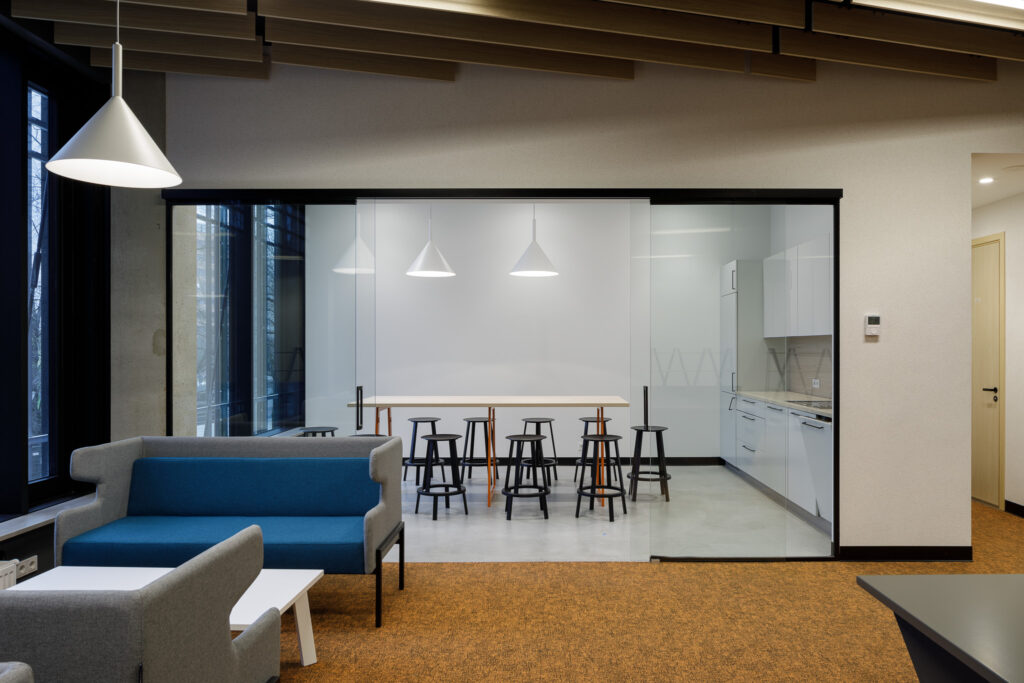
Successful practices for increasing communication are ones that do not compromise privacy in the work environment nor in the communal space. In Delta Centre, there are numerous kitchens for different faculty and a support unit. Students have their own kitchen. Bigger kitchens are accompanied with common rooms for leisure. Different areas around the building are designed as places to spend time according to one’s taste. Curtains allow for more privacy and the furniture is movable
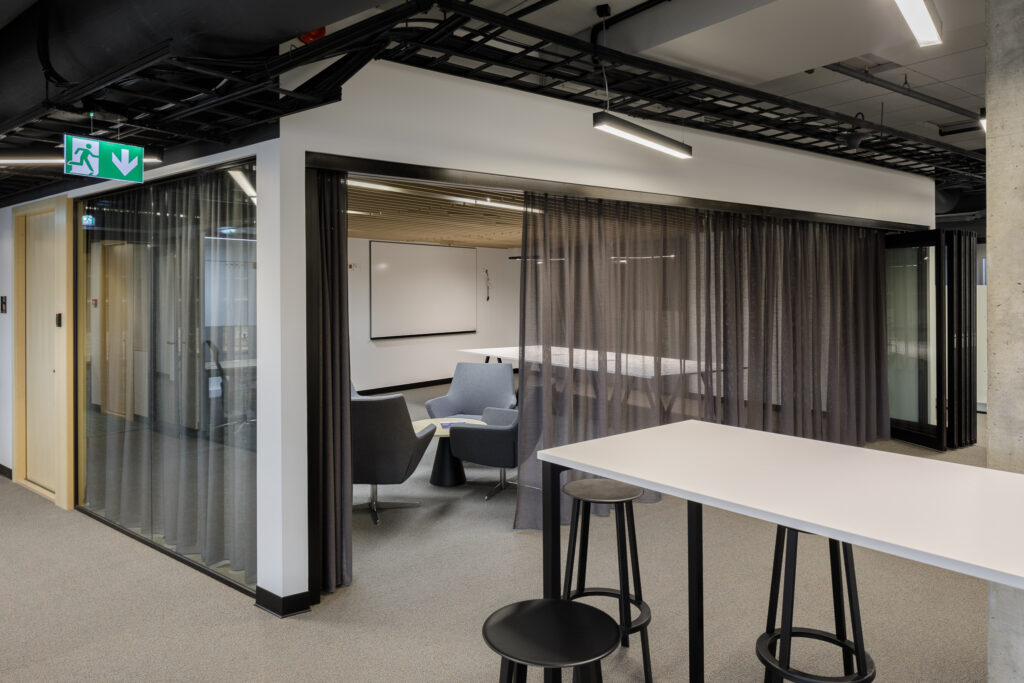
Control, territoriality and crowding
The creative house Vita has less diverse study and leisure areas. It comes down to the chance to have control over one’s immediate surroundings. If one’s location is lacking the desired properties, there should be an option to change the environment or continue with activities elsewhere. Basic Psychological Needs theory has been found to be relevant in the domains of work, school, sports and life in general.19 These three needs – need for autonomy, need for competence and need for relatedness – are necessary for well-being and internal motivation. Satisfying the need for autonomy is the basis of satisfying the need for competence and relatedness too. When failing to facilitate self-determined behaviour, one can not fully enjoy success or having a purpose either. If the environment offers choice, it gives users more control over the situation, thus enabling one to feel and behave more autonomously. In the creative house Vita, there are less choices than in Delta Centre’s study facility when it comes to different type of open spaces or regulating the conditions there.
Territoriality is a person’s wish to mark one’s acting space as being under one’s control.8 This means the ability to personalise it according to one’s preference, mark the ownership of the space or something in it and prevent others from using it. Control over one’s physical space has been found to be important for one’s well-being and job satisfaction.20 This helps to avoid unwanted social interactions that might burden one while being busy. Crowding occurs, when a person does not feel like she has enough private spaces. Crowding causes physiological alertness and discomfort, and has been identified as a stressor. The feeling of control makes any stressor more bearable. Not being able to switch off or leave the stressor makes it harder to tolerate these conditions. This is common in detention facilities, where prisoners have little to no control over their immediate surroundings.21
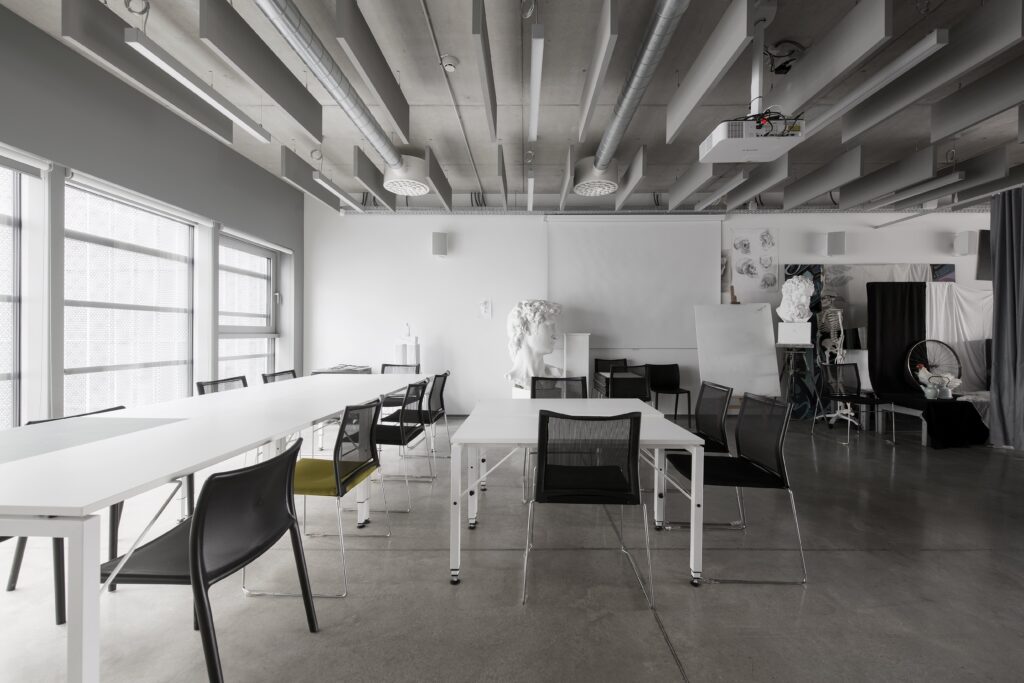
Students in the creative house Vita have their own dedicated studios according to speciality. Organising the space respectively supports autonomy and territoriality, and helps to avoid crowding. Laboratories in the Delta Centre’s study and research facility offer similar functions, but there are fewer students participating. In contrast to studios and laboratories, other study rooms and leisure areas in both buildings are organised as public spaces. Movable furniture, bean bags, pillows and other personal belongings help to mark and control one’s personal space there. Curtains in the creative house Vita and in the Delta Centre’s study and research facility allow to adjust one’s surroundings and mark one’s territory. Students in the creative house Vita are expected to fill the walls with their creation. Students in the Delta Centre’s study and research facility have a possibility to present their work publicly. This is a way to relate to and interact with their environment in a meaningful way, mark a territory, and evoke ownership and responsibility.
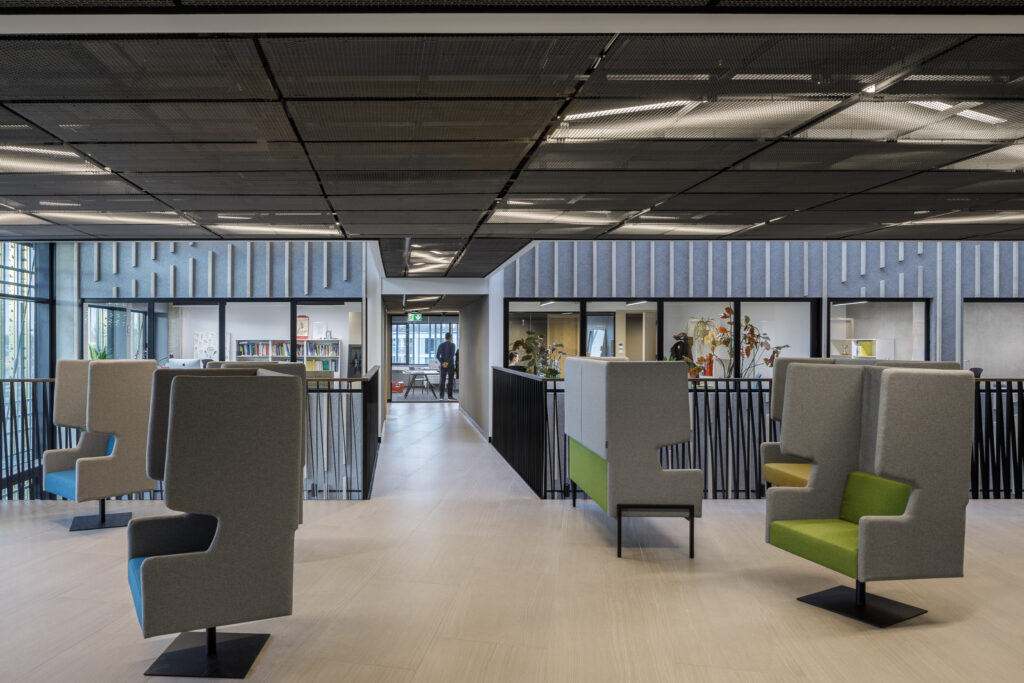
Speech, sound & noise
People are highly attuned to the human voice through evolution. It makes sense to be able to concentrate in great detail to what others are communicating. Intelligible speech is considered one of the biggest distractors in open-space offices.22 There is a way is to make the speech unintelligible by masking it with other continuous noise.23 This also happens, when many people speak at the same time, making it appear as random babble.24 The attention won’t be caught by the meaning. The sound of running water also works, masking the intelligible speech and other sudden auditory distractions.25 But the masking noise itself shouldn’t become noise. Otherwise it acts as a stressor. In the Delta Centre’s study and research facility there are soundproof rooms and cubicles with sound absorbing panels in the study and leisure area. Sound absorbing soft furniture is found all over the facility. There are soundproof music studios and a recording studio in the creative house Vita.
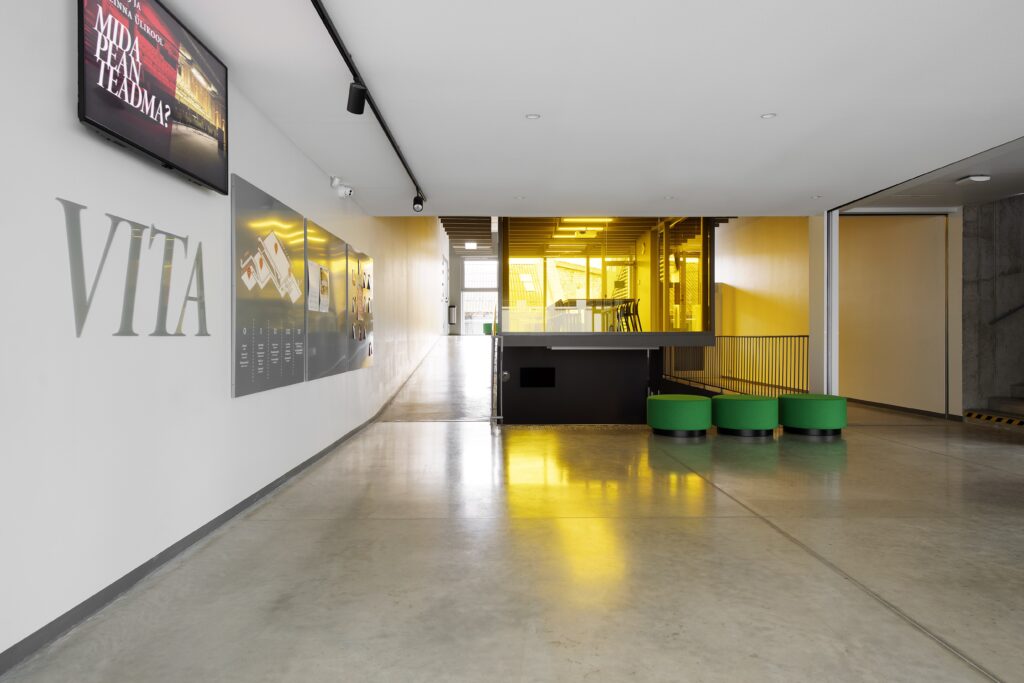
Illumination, visual perception, photobiology and views
In the faculty offices of the creative house Vita, the only source of direct daylight is a single roof window in the kitchen. Some cubicles get secondary daylight through the internal glass wall filtered with yellow film; others from dark hallways or a printer room. Daylight is related to our physiological and hormonal balance. Blue light during daytime is essential for healthy functioning, circadian rhythms, alertness, mood and cognitive functioning.26 Filtering out all other spectrums except yellow seems unnecessary and unhealthy, especially in our latitude. The regularly repeating daily exposure to light and dark results in a stable sleep-wake cycle, which is essential for mental and physical health.27 Importantly, the receptor cells responsible for regulating the sleep hormone are most sensitive to short-wavelengths like the blue light.
This yellow film is used on glass partitions throughout the building. While in the dance hall, yellow shade creates playful optics, its function in the seminar rooms and classrooms is questionable. Can one remain alert in these conditions? When natural light is not possible to use, one can design for alertness with artificial illumination. A study published in 2018 observed how wall luminance with spotlights led to a rise in performance and alertness.28 The eye catches more light when it enters the eye horizontally, therefore keeping us more alert.
Stress, attention restoration & cognition
How to recuperate, when we have worked under stress, exhausted our mental resources and the environment is not supporting our psychological functions? Good views play a big role in our attention restoration and stress reduction. Nature has properties that support restoring one’s attention and reducing stress levels.,29,30 Places that allow a shift towards more positively-toned emotional states, positive changes in physiological activity levels as well as behaviour and cognitive functioning are called restorative environments.31 Respondents who looked at a flowering meadow green roof for 40 seconds performed better in cognitive ability tests than those who looked at a concrete roof.32 This shows that even microbreaks while looking nature can have an effect on attention restoration.
While Delta Centre has exploited the views to the river and the surrounding trees, the creative house Vita hasn’t implemented the few opportunities its courtyard offers. Passageways and staircases where nobody spends their time benefit most from the already scarce greenery, leaving people in offices and classrooms without the potential advantages. Views over the neighbouring buildings from classrooms on Vita’s higher floors offer variety and fascination.
Outdoors
In modern urbanised societies, stress and insufficient ways to recover are recognised as a growing problem and a cause of long-term effects on health.33 Living and working in busy, overcrowded and information-rich cities drains mental resources31 and contributes to the so-called ‘technostress’. How to resolve this.
In addition to views of nature, findings suggest that contact with outdoor nature during work hours is associated with better health, higher well-being, less stress34 and lower mortality rates.35 There is evidence that urban green areas like parks work better than built environments for reducing stress and restoring attention.32 Also, waterscapes or blue spaces are considered more restorative and healthy than green spaces.36
Human health benefits associated with immersion in nature have received increasing attention from the perspective of preventive medicine in the recent years.37 Delta Centre, situated next to the river and park, can offer conditions similar to the practice of Shinrin-Yoku, also known as Forest Bathing.38 Various contemporary hypotheses, such as Kaplan’s Attention Restoration Hypothesis, Ulrich’s Stress Reduction Hypothesis, or Kellert and Wilson’s Biophilia Hypothesis provide support and a lens for engagement with nature.39
According to the Biophilia Hypothesis, human beings subconsciously feel attracted to and seek nature, because our nervous system has evolved in a natural environment and is calibrated by it. Nature is fascinating due to its unique never-recurring patterns and perceived complexity.40 Being in nature has effects on the immune system, cardiovascular system, the respiratory system, mood disorders, stress and anxiety, mental relaxation and, human feelings of ‘awe’, the increase in gratitude and selflessness.41
This is all accessible from the south and west sides of the Delta Centre without having to come into direct contact with urban stressors. The mere act of listening to the sounds of nature is capable of inducing relaxation via the endocrine and nervous system.42 Roaring water can protect and promote health by masking traffic noise.,43,44 The sound of the running water and the rustling trees benefits the health, well-being, restoration and creates an auditory buffer zone from the overstimulating urban environment. According to case studies in Copenhagen, Cologne and Dusseldorf, urban blue spaces similar to Delta Centre’s surroundings improve physical activity, social interaction and restoration.45 These green and blue areas were an argument for the University of Tartu and the municipality of Tartu when choosing the location for the Delta Centre.
There is less access to nature in the courtyard in front of the creative house Vita. Vita is located in a high-density urban area, surrounded by buildings. Although there are some plant beds and birch trees, the surrounding landscape is overall dominated by pavement stone. However, an artificial environment can also be restorative,46 when not overstimulating.47 What makes an environment restorative? Attention has two mechanisms—involuntary fascination and voluntary effort.48 Fascination plays a crucial role in attention restoration, as it provides the opportunity for a depleted attentional system to rest. Voluntary attention is used when fascination is missing and interest fails, but a stimulus must be attended to anyway. Attention that requires effort is susceptible to fatigue, resulting in cognitive decline.49
In contrast, involuntary attention arises when environmental qualities can facilitate fascination, coherent spatial experience, escape from daily routine and person’s intentions.50 In order to wander and get fascinated, one must be able to lose himself in the environment. Studies have shown that 1) cultural, historical and religious sites; 2) recreational leisure areas; and 3) panoramic places have high restorative potential. Architectural elements and variation in the building facade play an important role in the restorative process. This partly explains why historical buildings, often rich in facade elements, are perceived as restorative. The buildings in the campus of Tallinn University are tightly packed. Cultural and historical layering can be seen in the courtyard with old and new buildings side by side. An aesthetically pleasurable experience can bring about restorative effects when the environment provides meaning through symbolic associations,51 like designated names for different buildings.
Conclusion
In essence and in function, the Delta Centre’s teaching and research facility and the creative house Vita are two very different buildings. Both facilities have features that can either empower or limit the inhabitants. The environment can have a devastating effect on our psychological and physiological functioning, but the environmental psychology shows us, how to take it into consideration.

SILVER STERNFELDT is an environmental psychologist developing the field of evidence-based design. He has taught and supervised theses in the Estonian Academy of Arts and Tallinn University of Technology, and managed different person-centered space projects for public sector organisations. Silver is the founder of Keskkonnapsühholoogia uuringud OÜ.

AKSEL PART is an urbanist and sustainable urban mobility expert working in the Baltic Environmental Forum.
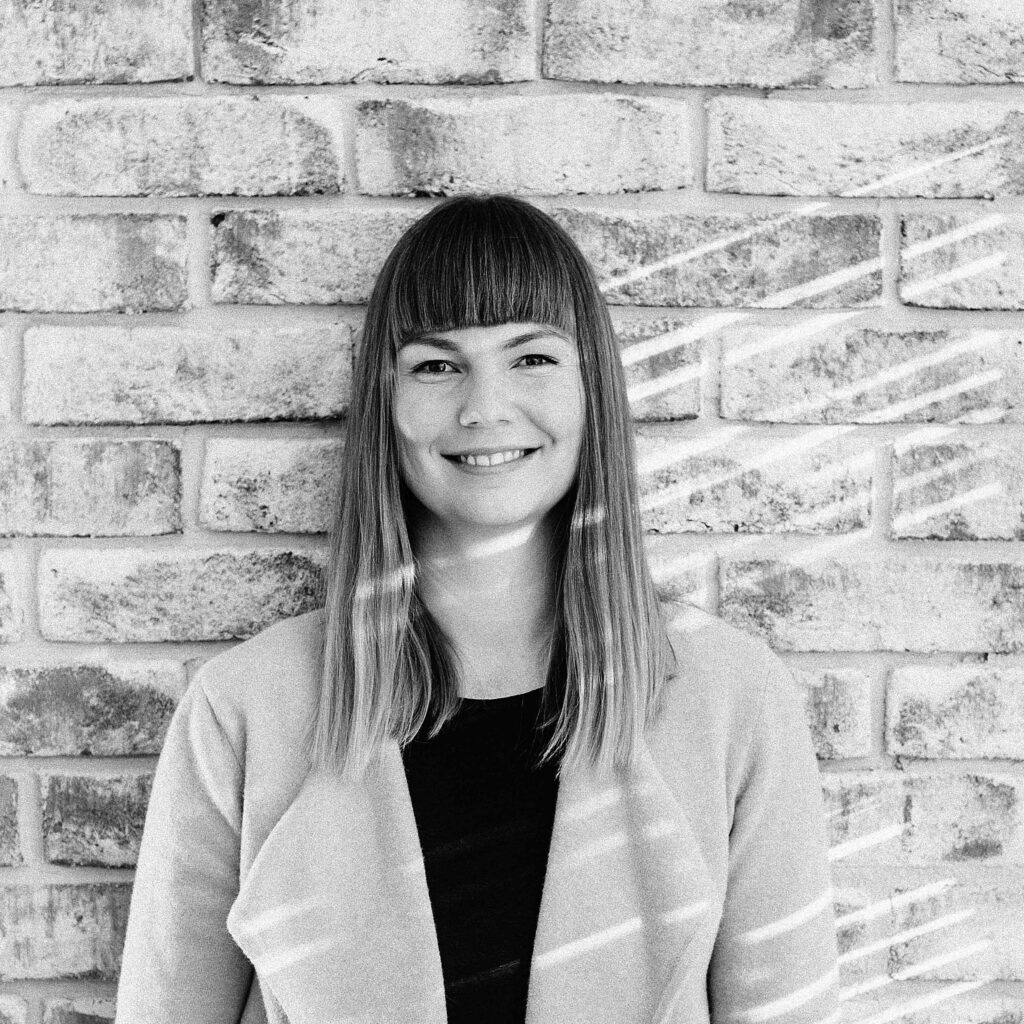
MARJU RANDMER-NELLIS is an editor by education, previously worked as a creative director and photographer, and is currently studying environmental design at the Estonian Academy of Arts.

JULIA TRUNOVA is an architect working in private and public sectors. She has worked at Kauss Arhitektuur and Varjund and currently works as an architect in the Tallinn Urban Planning Department.
HEADER: Delta Centre, University of Tartu. Photo by Maris Tomba
PUBLISHED: Maja 101-102 (summer-autumn 2020) Interior Design
1 McCambridge, Jim, John Witton, and Diana R. Elbourne. Systematic review of the Hawthorne effect: new concepts are needed to study research participation effects. – Journal of clinical epidemiology 67, no. 3 (2014), pp. 267–277.
2 Levitt, Steven D., and John A. List. Was there really a Hawthorne effect at the Hawthorne plant? An analysis of the original illumination experiments. – American Economic Journal: Applied Economics 3, no. 1 (2011), pp. 224–238.
3 Izawa, Masumi R., Michael D. French, and Alan Hedge. Shining new light on the Hawthorne illumination experiments. – Human factors 53, no. 5 (2011), pp. 528–547.
4 Jones, Stephen RG. Was there a Hawthorne effect? – American Journal of sociology 98, no. 3 (1992), pp. 451–468.
5 Brill, M., S. Weidemann, J. Olsen, and E. Keable. Bosti (2001). Disproving widespread myths about workplace design. Research report.
6 Wineman, Jean D., and Janice Barnes. Workplace Settings. – In Environmental Psychology and Human Well-Being, pp. 167–192. Academic Press, 2018.
7 McCoy, Janetta Mitchell. Work environments. – Handbook of environmental psychology (2002), pp. 443–460.
8 Veitch, Jennifer A. Work environments. The Oxford Handbook of Environmental and Conservation Psychology (2012).
9 Maxwell, Lorraine E. The Role of the Physical Environment in Education. – In Environmental Psychology and Human Well-Being, pp. 135–166. Academic Press, 2018.
10 Węziak-Białowolska, Dorota, Zhao Dong, and Eileen McNeely. Turning the Mirror on the Architects: A Study of the Open-Plan Office and Work Behaviors at an Architectural Company. – Frontiers in Psychology 9 (2018), pp. 2178.
11 Haapakangas, Annu, Valtteri Hongisto, Jukka Hyönä, Joonas Kokko, and Jukka Keränen. Effects of unattended speech on performance and subjective distraction: The role of acoustic design in open-plan offices. – Applied Acoustics 86 (2014), pp. 1–16.
12 Spivack, J. A., A. D. Askay, and G. S. Rogelberg. Contemporary physical workspaces: A review of current research, trends, and implications for future environmental psychology inquiry. – Environmental psychology new developments (2009), pp. 37–62.
13 Brill, Michael, Stephen T. Margulis, and Ellen Konar. Using office design to increase productivity. Vol. 2. Workplace Design and Productivity, Inc., 1985.
14 Howard, Steven J., Janice Johnson, and Juan Pascual-Leone. Clarifying inhibitory control: Diversity and development of attentional inhibition. – Cognitive Development 31 (2014), pp. 1–21.
15 Neill, W. Trammell, Leslie A. Valdes, and Kathleen M. Terry. Selective attention and the inhibitory control of cognition. – In Interference and inhibition in cognition, pp. 207–261. Academic Press, 1995.
16 Buzsáki, György, Kai Kaila, and Marcus Raichle. Inhibition and brain work. – Neuron 56, no. 5 (2007), pp. 771–783.
17 Wolfe, Benjamin, Jonathan Dobres, Ruth Rosenholtz, and Bryan Reimer. More than the Useful Field: Considering peripheral vision in driving. – Applied ergonomics 65 (2017), pp. 316–325.
18 Albonico, Andrea, Manuela Malaspina, Emanuela Bricolo, Marialuisa Martelli, and Roberta Daini. Temporal dissociation between the focal and orientation components of spatial attention in central and peripheral vision. – Acta psychologica 171 (2016), pp. 85–92.
19 Deci, Edward L., and Richard M. Ryan. The „what“ and „why“ of goal pursuits: Human needs and the self-determination of behavior. – Psychological inquiry 11, no. 4 (2000), pp. 227–268.
20 Wells, Meredith M. Office clutter or meaningful personal displays: The role of office personalization in employee and organizational well-being. – Journal of environmental psychology 20, no. 3 (2000), pp. 239–255.
21 Wener, Richard. The environmental psychology of prisons and jails: Creating humane spaces in secure settings. Cambridge University Press, 2012.
22 Jahncke, Helena, Valtteri Hongisto, and Petra Virjonen. Cognitive performance during irrelevant speech: Effects of speech intelligibility and office-task characteristics. – Applied Acoustics 74, no. 3 (2013), pp. 307–316.
23 Hongisto, Valtteri, Johanna Varjo, Henri Leppämäki, David Oliva, and Jukka Hyönä. Work performance in private office rooms: The effects of sound insulation and sound masking. – Building and Environment 104 (2016), pp. 263–274.
24 Zaglauer, Maria, Horst Drotleff, and Andreas Liebl. Background babble in open-plan offices: A natural masker of disruptive speech? – Applied Acoustics 118 (2017), pp. 1–7.
25 Lee, Hsiao Mun, and Heow Pueh Lee. Noise masking in high population country using sound of water fountain. – Applied Acoustics 162 (2020), 107206.
26 Münch, Mirjam, Friedrich Linhart, Apiparn Borisuit, Susanne M. Jaeggi, and Jean-Louis Scartezzini. Effects of prior light exposure on early evening performance, subjective sleepiness, and hormonal secretion. – Behavioral neuroscience 126, no. 1 (2012), pp. 196.
27 Kort de Y, Veitch JA. From blind spot into the spotlight: introduction to the special issue light, lighting, and human behaviour . – J Environ Psychol [Internet] 39 (2014), pp.1–4.
28 de Vries, Adrie, Jan L. Souman, Boris de Ruyter, Ingrid Heynderickx, and Yvonne AW de Kort. Lighting up the office: The effect of wall luminance on room appraisal, office workers performance, and subjective alertness. – Building and Environment 142 (2018), pp. 534–543.
29 Kaplan, Rachel, and Stephen Kaplan. The experience of nature: A psychological perspective. CUP Archive, 1989.
30 Ulrich, Roger S., Robert F. Simons, Barbara D. Losito, Evelyn Fiorito, Mark A. Miles, and Michael Zelson. Stress recovery during exposure to natural and urban environments. – Journal of environmental psychology 11, no. 3 (1991), pp. 201–230.
31 Berto, Rita. The role of nature in coping with psycho-physiological stress: a literature review on restorativeness. – Behavioral sciences 4, no. 4 (2014), pp. 394–409.
32 Lee, Kate E., Kathryn JH Williams, Leisa D. Sargent, Nicholas SG Williams, and Katherine A. Johnson. 40-second green roof views sustain attention: The role of micro-breaks in attention restoration. – Journal of Environmental Psychology 42 (2015), pp. 182–189.
33 Tyrväinen, Liisa, Ann Ojala, Kalevi Korpela, Timo Lanki, Yuko Tsunetsugu, and Takahide Kagawa. The influence of urban green environments on stress relief measures: A field experiment. – Journal of environmental psychology 38 (2014), pp. 1–9.
34 Wells, Nancy M., and Kimberly Bosworth Phalen. Everyday and nearby natural environments. – In Environmental Psychology and Human Well-Being, pp. 221–251. Academic Press, 2018.
35 Maas, Jolanda, Robert A. Verheij, Sjerp de Vries, Peter Spreeuwenberg, Francois G. Schellevis, and Peter P. Groenewegen. Morbidity is related to a green living environment. – Journal of Epidemiology & Community Health 63, no. 12 (2009), pp. 967–973.
36 White, Mathew P., Ian Alcock, Benedict W. Wheeler, and Michael H. Depledge. Coastal proximity, health and well-being: results from a longitudinal panel survey. – Health & place 23 (2013), pp. 97–103.
37 Ideno, Yuki, Kunihiko Hayashi, Yukina Abe, Kayo Ueda, Hiroyasu Iso, Mitsuhiko Noda, Jung-Su Lee, and Shosuke Suzuki. Blood pressure-lowering effect of Shinrin-yoku (Forest bathing): a systematic review and meta-analysis. – BMC complementary and alternative medicine 17, no. 1 (2017), pp. 409.
38 Oh, Byeongsang, Kyung Ju Lee, Chris Zaslawski, Albert Yeung, David Rosenthal, Linda Larkey, and Michael Back. Health and well-being benefits of spending time in forests: systematic review. – Environmental Health and Preventive Medicine 22, no. 1 (2017), pp. 71.
39 Hansen, Margaret M., Reo Jones, and Kirsten Tocchini. Shinrin-yoku (forest bathing) and nature therapy: A state-of-the-art review. – International journal of environmental research and public health 14, no. 8 (2017), pp. 851.
40 Van den Berg, Agnes E., Yannick Joye, and Sander L. Koole. Why viewing nature is more fascinating and restorative than viewing buildings: A closer look at perceived complexity. – Urban Forestry & Urban Greening 20 (2016), pp. 397–401.
41 Williams, Florence. This is your brain on nature. – Natl. Geogr 229 (2016), pp. 48–69.
42 Thoma, Myriam Verena, Ricarda Mewes, and Urs M. Nater. Preliminary evidence: the stress-reducing effect of listening to water sounds depends on somatic complaints: a randomized trial. – Medicine 97, no. 8 (2018).
43 Jeon, Jin Yong, Pyoung Jik Lee, Jin You, and Jian Kang. Perceptual assessment of quality of urban soundscapes with combined noise sources and water sounds. – The Journal of the Acoustical Society of America 127, no. 3 (2010), pp. 1357–1366.
44 You, Jin, Pyoung Jik Lee, and Jin Yong Jeon. Evaluating water sounds to improve the soundscape of urban areas affected by traffic noise. – Noise Control Engineering Journal 58, no. 5 (2010), pp. 477–483.
45 Völker, Sebastian, Angela Heiler, Thorsten Pollmann, Thomas Claßen, Claudia Hornberg, and Thomas Kistemann. Do perceived walking distance to and use of urban blue spaces affect self-reported physical and mental health? – Urban Forestry & Urban Greening 29 (2018), pp. 1–9.
46 Patuano, Agnès. Biophobia and Urban Restorativeness. – Sustainability 12, no. 10 (2020), pp. 4312.
47 Valtchanov, Deltcho, and Colin G. Ellard. Cognitive and affective responses to natural scenes: effects of low level visual properties on preference, cognitive load and eye-movements. – Journal of Environmental Psychology 43 (2015), pp. 184–195.
48 Berto, Rita, Maria Rosa Baroni, Alessandra Zainaghi, and Sandro Bettella. An exploratory study of the effect of high and low fascination environments on attentional fatigue. – Journal of environmental psychology 30, no. 4 (2010), pp. 494–500.
49 Bruckmaier, Merit, Ilias Tachtsidis, Phong Phan, and Nilli Lavie. Attention and capacity limits in perception: A cellular metabolism account. – Journal of Neuroscience (2020).
50 Weber, Anke Maria, and Jörg Trojan. The restorative value of the urban environment: A systematic review of the existing literature. – Environmental Health Insights 12 (2018), pp. 1-13.
51 San Juan, César, Mikel Subiza-Pérez, and Laura Vozmediano. Restoration and the city: the role of public urban squares. – Frontiers in psychology 8 (2017), pp. 2093.


